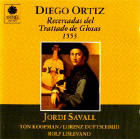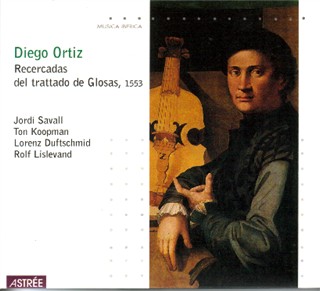|
Diego Ortiz
(ca. 1510 - ca. 1570)
Recercadas del
Trattado de Glosas, Roma 1553 |
|
/aliavox_heritage.jpg) |
|
Alia Vox AVSA9899
Code-barres/Barcode:
7619986398990 |
|
Édition remasterisée |
Remastered edition |
|
Super Audio CD |
|
|
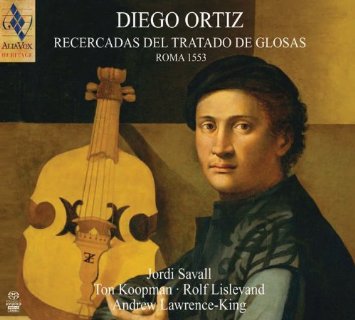
|
Description
Artistes / Performers
Jordi Savall, Ton Koopman, Lorenz Duftschmid, Rolf
Lislevand, Paolo Pandolfo, Andrew Lawrence-King
Lieu d'enregistrement / Recording site:
Pieve de S. Martino, Emilia
Dates d'enregistrement: Avril 1989
Recording dates: April 1989
Durée totale / Total time: 49"35

|
|
|
 |
|
 En 1553, paraît à Rome son Tratado de glosas
sobre cláusulas y otros généros de puntos en la música de violones
nuevamente puestos en luz, publié en espagnol et en italien.
Les glosas sont des variations interprétées soit par des
solistes soit par deux musiciens jouant d'instruments semblables.
Ce traité présente également des recercadas (ou ricercari),
principalement des variations musicales, pouvant être jouées par
de petits groupes d'instrumentistes.
En 1553, paraît à Rome son Tratado de glosas
sobre cláusulas y otros généros de puntos en la música de violones
nuevamente puestos en luz, publié en espagnol et en italien.
Les glosas sont des variations interprétées soit par des
solistes soit par deux musiciens jouant d'instruments semblables.
Ce traité présente également des recercadas (ou ricercari),
principalement des variations musicales, pouvant être jouées par
de petits groupes d'instrumentistes.
(Wikipedia)
 The Trattado de Glosas (modern Spanish
spelling Tratado de Glosas) is considered a masterpiece of
literature for the viola da gamba. The work was published on
10 December 1553, in Rome under the Spanish title
Trattado de glossas sobre clausulas y otros generos de
punctos en la musica de violones nuevamente puestos en luz.
Its Italian title is Glose sopra le cadenze et altre
sorte de punti in la musica del violone.
The Trattado de Glosas (modern Spanish
spelling Tratado de Glosas) is considered a masterpiece of
literature for the viola da gamba. The work was published on
10 December 1553, in Rome under the Spanish title
Trattado de glossas sobre clausulas y otros generos de
punctos en la musica de violones nuevamente puestos en luz.
Its Italian title is Glose sopra le cadenze et altre
sorte de punti in la musica del violone.
(Wikipedia)
|
|
Évaluations recensées / Reviews
located |
|

05/1991
(see below)
|

# 363 (09/1990)
(voir ci-dessous)
# 618
(11/2013) |

# 33 (06/2091)
(voir ci-dessous) |
|

14:3 (01-02 / 1991)
(see below) |

John Sunier
    |

(01/2014)
(see below) |
|

Diego Ortiz (ca. 1510-ca.1570 |

Diego Ortiz (c. 1510- c. 1570) |
|
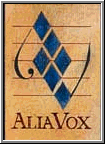
Extrait du livret / From the liner notes |
|
 Le 10 décembre 1553, en l’un des moments privilégiés du
rayonnement de l’âge d’or musical espagnol, fut imprimé à Rome le
TRATTADO DE GLOSAS SOBRE CLAUSULAS Y OTROS GENEROS DE PUNTOS EN LA
MUSICA DE VIOLONES NUEVAMENTE PUESTOS EN LUZ de Diego Ortiz, connu
aussi sous le nom de « el Toledano ». Référence incontournable
pour l’étude de la pratique instrumentale du XVIe siècle, cette
œuvre présente un intérêt exceptionnel, tant du point de vue
purement historique que par sa valeur artistique, puisqu’elle
contient les plus beaux exemples du répertoire connu pour viole de
gambe (vihuela de arco ou violone) et clavecin au temps de la
Renaissance.
Le 10 décembre 1553, en l’un des moments privilégiés du
rayonnement de l’âge d’or musical espagnol, fut imprimé à Rome le
TRATTADO DE GLOSAS SOBRE CLAUSULAS Y OTROS GENEROS DE PUNTOS EN LA
MUSICA DE VIOLONES NUEVAMENTE PUESTOS EN LUZ de Diego Ortiz, connu
aussi sous le nom de « el Toledano ». Référence incontournable
pour l’étude de la pratique instrumentale du XVIe siècle, cette
œuvre présente un intérêt exceptionnel, tant du point de vue
purement historique que par sa valeur artistique, puisqu’elle
contient les plus beaux exemples du répertoire connu pour viole de
gambe (vihuela de arco ou violone) et clavecin au temps de la
Renaissance.
Peu nous est connu, à ce jour, de la vie du violiste et
compositeur espagnol Diego Ortiz. Les premières traces de
son existence coïncident avec la date de publication à Rome
du Trattado de Glosas (1553). L’étendue des connaissances
que suppose la réalisation d’une telle œuvre incite à penser
qu’elle a été composée alors qu’Ortiz était déjà un homme
mûr (composée ou rééditée, si toutefois il venait à se
confirmer que le contenu du traité a été « remis à jour » en
cette année 1553). Lorsqu’il quitta son pays natal, Diego
Ortiz avait déjà acquis une formation musicale complète. On
en veut pour preuve l’aspect nettement précurseur de son
traité du strict point de vue de l’écriture musicale. Une
comparaison avec la Regola rubertina (Venise, 1542-43) de
Sylvestro Ganassi, traité publié dix ans avant celui d’Ortiz
et dédié tout particulièrement à l’étude de la technique
violistique, ainsi que le caractère indéniablement
hispanique de l’œuvre de Diego Ortiz, confortera l’hypothèse
suivant laquelle Ortiz avait déjà acquis une formation
musicale complète lorsqu’il quitta son pays d’origine.
Toutefois, malgré de récentes recherches menées dans sa
ville natale, nous continuons d’ignorer les dates exactes de
sa naissance, le lieu où il reçut sa formation musicale,
ainsi que le type d’activité qu’il exerça avant son voyage
en Italie.
Extrait du livret
 On 10th December, 1553, at one of the highpoints in the Golden Age
of Spanish music, there appeared in Rome the TRATTADO DE GLOSAS
SOBRE CLAUSULAS Y OTROS GENEROS DE PUNTOS EN LA MUSICA DE VIOLONES
NUEVAMENTE PUESTOS EN LUZ by Diego Ortiz, who was also known under
the name “el Toledano”. An inevitable reference point for the
study of instrumental performance practice in the 16th century,
this work is of exceptional interest, both for its purely
historical significance and for its artistic value, since it
contains the finest examples of the known repertoire for viola da
gamba (vihuela de arco or violone) and harpsichord in the
Renaissance period.
On 10th December, 1553, at one of the highpoints in the Golden Age
of Spanish music, there appeared in Rome the TRATTADO DE GLOSAS
SOBRE CLAUSULAS Y OTROS GENEROS DE PUNTOS EN LA MUSICA DE VIOLONES
NUEVAMENTE PUESTOS EN LUZ by Diego Ortiz, who was also known under
the name “el Toledano”. An inevitable reference point for the
study of instrumental performance practice in the 16th century,
this work is of exceptional interest, both for its purely
historical significance and for its artistic value, since it
contains the finest examples of the known repertoire for viola da
gamba (vihuela de arco or violone) and harpsichord in the
Renaissance period.
We know little today about the life of the Spanish viol
player and composer Diego Ortiz. The first signs of his
existence occur at the same time as the publication in Rome
of the Trattado de Glosas (1553). The extent of knowledge
required for the compilation of such a work leads us to
think that it was composed when Ortiz was already in his
maturity. It was composed – or revised, which seems to be
the implication of the indication that the treatise was
“nuevamente puestos en luz” (newly published), in the year
1553. By the time that he left his native country, Diego
Ortiz had already completed his musical education. This is
shown by the clear pioneering nature of his treatise from
the strict point of view of musical style. A comparison with
Sylvestro Ganassi's Regola rubertina (Venice, 1542-43), a
treatise printed ten years before that of Ortiz and
specifically dedicated to a study of viol technique, as well
as the underniably Hispanic character of the work by Diego
Ortiz, supports the hypothesis that Ortiz had already
completed his musical education when he left his native
country. However, despite recent research in his native
town, we still do not know the exact date of his birth or
the place where he received his musical education or even
what he did before he undertook his journey to Italy.
From the liner notes |
|
Gramohone
(05/1991) |
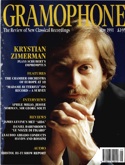 |
Subscription
Abonnement |
Reviewer: Tess Knighton
The
importance of Diego Ortiz's Trattado de glosas (1553) for our
understanding of instrumental composition and practice in the
sixteenth century has long been acknowledged in the text books of
music history. What has been less readily appreciated—largely for
want of a decent recording—is the value and interest of the music
Ortiz composed by way of illustrating his technical points on how to
ornament and improvise. To remedy this situation, Jordi Savall with
a continuo team including such stars in their respective fields as
Ton Koopman and Andrew Lawrence-King, has recorded a carefully
chosen selection of the various kinds of pieces advocated by Ortiz
in persuasive and impressively technically-assured performances.
Indeed, listening to Savall's total assurance on the gamba, the
sheer range of tone colour he has at his fingertips and the apparent
ease with which he negotiates the trickiest of passages, reminds one
of his great musical strengths, not so readily appreciated, I've
found, when he substitutes the baton for the bow—as, rather sadly,
seems to be increasingly the case these days.
Most immediately appealing to the nonspecialist listener will
undoubtedly be the selection of recercadas (or ricercars) on
well-known ground basses, each given a varied treatment in terms of
continuo accompaniment and strongly characterized by Savall who
brings out now the plaintive, expressive qualities of his
instrument, now the rhythmic, dancey edge of the chiff of bow on
string. The playing is always stylish, never mannered, with the
unfettered feel of the imaginative improviser: for once, a note that
describes the instrumentalist's art as ''stripped of all transcen-
dental pretention but abounding in life, imagination and spontaneity''
can be accurately applied to the recording itself.
Savall is admirably supported at every turn by his continuo team; my
only slight reservation about the recording is the distracting
whisper of the blower in the organ-accompanied items. The inevitable
penalty of a closely miked recording such as this, it is a small
price to pay for the pleasure of the disc as a whole. |
|
Diapason- # 618
(11/2013) |
 |
 |
Abonnement
Subscription |
Analyste: Gaëtan Naulleau
- Les hifistes se pâmeront avec l'album Diego Ortiz, pour lequel
Manuel Mohino signait en 1989 une prise de son anthologique. La
grosse viole italienne de 1550 au grain rugueux est là devant nous,
à portée de main, légèrement à gauche, secondée par quelques
compagnons (orgue, harpe, violone, vihuela); on voit les légers
mouvements de Savall et de son instrument, on suit la propagation du
timbre dans l'espace. Magnifique. Il n'en fallait pas moins pour que
nous appréciions à sa juste valeur la relecture du recueil publié
par Ortiz à Rome en 1553, à l'origine catalogue de gloses -
autrement dit, manuel illustré d'improvisation - mais ici véritable
De natura sonoris. Sous l'archet du magicien, les diminutions
d'Ortiz ne sont plus des notes ajoutées, mais une façon de faire
"vibrer" autrement la matière résonnante du timbre". |
Diapason- # 363
(09/1990) |
|
Appréciation
4 diapasons
Evaluation |
Abonnement
Subscription |
Analyste: Denis
Morrier
En abrégé:
Denis Morrier souligne à juste titre l'importance de cet
enregistrement consacré aux "recarcadas" de Diego Ortiz. Il écrit:
"C'est ... une nouvelle révélation qu'apporte Jordi Savall (comme
chaque fois dans ces répertoires anciens qu'il aborde avec une
ouverture d'esprit peu commune, ...) ; non seulement celle d'un
musicien-théoricien fameux ..., mais aussi celle d'un art
bouillonnant et tumultueux, animé de passions exacerbées et de
tensions sans cesse ravivées".
Il ajoute plus loin que "Jordi Savall offre un large aperçu des
différentes formes de ricercadas répertoriées par Ortiz
(seules celles sur des mélodies grégoriennes ne sont pas
représentées), agrémentant ses choix par des accompagnements d'une
grande variété, toujours admirablement réalisés. On peut ainsi
apprécier la volubilité et l'exubérance rythmique coutumière à Ton
Kookman dans ce répertoire - le claveciniste n'hésitant pas à
engager de véritables joutes virtuoses avec le soliste - ainsi que
l'invention et la délicatesse du harpiste Andrew Lawrence-King.
Aussi admirablement soutenu, Jordi Savall peut donner libre cours à
son inspiration poétique, déniant tout sens exclusivement décoratif,
mais leur offrant au contraire une vraie dimension dramatique,
faisant d'elles les vrais guides et révélateurs des pièces variées."
Morrier conclue son article en qualifiant Savall "d'Ange de la
Viole (qui) nous livre ... un nouveau miracle, magnifiant
ces oeuvres didactiques pour mieux illuminer, d'une lumière
insoupçonnée, l'art finalement bien méconnu de la Renaissance". |
Reviewer: Denis
Morrier
Abridged version :
"Denis Morier underlines quite judiciously
the importance of this recording of the "recarcadas" of Diego Ortiz.
He writes: " This is "... another revelation from Savall (as always
in those ancient repertories that he explores with such an open
mindedness,...); not only does it come from a famous musician and
theorician..., but it stems from a buoyant and tumultuous art, full
of exacerbated passions and tensions which are continuously revived."
As we read on, he mentions that "Savall provides a broad selection
from the various types of ricercadas located by Ortiz (only
those based on Gregorian melodies are excluded), thus embelishing
his choices with accompaniements of a wide variety, always splendily
performed. We can appreciate the volubility and the rythmic
exhuberance which characterizes Ton Koopman's performance - the
hapsichordist often engaging in truly virtuso exchanges with the
soloist - as well as the inventiveness and delicacy of the harpist,
Andre Lawrence-King. Being so well supported, Jordi Savall can let
go all his poetical inspiration, without adornments, but giving to
these pieces on the contrary a truly dramatic dimension... ".
Morier concludes his review by branding Savall as "the angel
of the viola da gamba who performs... another miracle, giving a new
dimension to these didactic pieces and puts them in a new
perspective, shedding a new light on the Renaissance period."
|
|

14:3 (01-02 / 1991) |
 |
Subscription
Abonnement |
|
Reviewer:
J. F. Weber
The “Trattado de Glosas“ was published in Rome in 1553 by Diego
Ortiz, an émigré Spaniard from Toledo whose previous years have left
no trace, although he was clearly a mature artist educated in his
native country. It should be no surprise that he then went to Naples
where he directed the music at the court of the Spanish viceroy, who
was also from Toledo.
This work is actually a tract on viol playing illustrated by musical
examples. There are several types of Ricercadas (or ricercari)
represented in this selection, including a whole group based on “La
Spagna“ and a couple of short ones on “La Folia“; other groups are
based on Arcadelťs O felici occhi miei and Sandrin's Doulce Mémoire.
Some of these selections were the first examples of Ortiz ever
recorded, on an August Wenzinger disc (Archive ARC 3078), part of
which was issued in Europe as a 45-rpm single in the early 1950s.
Savall uses his ensemble to render these pieces with considerable
variety. Their skill is familiar, as is their interest in neglected
repertoire. The recording is very fine, captured in a suitable
location in Emilia not familiar from previous disc credits. Savall's
notes tell what little is known about the composer and concentrate
on the technical aspects of the music. Ortiz is better represented
on discs than before, but this must be one of the best productions
he has ever received.
|
|
Classica- # 33
(06/2001)
|
 |
Appréciation
Note: 5
Evaluation
|
Abonnement
Subscription |
Évaluation collective par par
J.-N. Coucouroux, S. Friedrich, S.Perreau
Texte abrégé:
Les analystes de Classica constatent que "Savall
réussit ... à faire de ce recueil (du Castillan Diego Ortiz) un simple jeu d'une
aisance confondante, où l'harmonie osée et les prouesses techniques semblent
naturelles". On nous souligne que " peu d'artistes se sont penchés au disque,
sur le fameux Traité des Gloses de 1553, laissé par le Castillan Diego
Ortiz aux générations de violistes suivantes. Ce recueil, sorte d'exemple rituel
de l'art de l'ornementation (Glosas), ou plus exactement de la
*diminution* sur un thème simple, est aujourd'hui principalement connu des
interprètes pour son extrême difficulté et son côté didactique."
|
Reviewer: Collective
review signed by J.-N. Coucouroux, S. Friedrich, S. Perreau
Abridged version in a free translation:
The reviewers acknowledge that "Savall
succeeds... in making an stunningly easy game of this collection of
works by the Castllian composer Diego Ortiz. The technical prowesses
and the challenging harmony of the pieces all seem so natural. They
mention that few musicians have tackled this famous
Recercadas del Trattadoleft
by Diego Ortiz to the next
generations of viol players. This collection, a sort of formal
example of the art of ornamentation (Glosas), or to be more specific
of the diminuendo on a simple theme, is nowaday essentially
recognized by musisians for its extreme difficulty and its didactic
value."
|
|
|
|

(01/2014) |
 |
|
|
Reviewer: Christopher
Price
Abridged version
This is the sixteenth disc in Alia Vox’s ‘ Heritage Series ’
reissuing the recordings made by Jordi Savall and his ensemble
Hespèrion XX for the Astrée label in the 1980s and 1990s. There are
no musical additions to the original programme and the booklet
provides Savall’s original notes, giving a detailed account of the
little that is known about Diego Ortiz and an informative
description of the music from his Trattado de Glosas of 1553. The
bonus, besides the glossy new packaging, is that this hybrid SACD
contains not only the original standard CD recording but also two
high-resolution versions in DSD format, one stereo and the other
multi-channel. The stereo DSD version, which can be played only on a
dedicated SACD player, certainly sounds more detailed and airier
than the already impressively sound- engineered original CD version,
with the balance between Savall’s solo viol and the accompanying
instruments benefiting especially from the new format. As with
earlier discs in the ‘ Heritage Series ‘ , the surround-sound
effects (or front centre and two rear speaker tracks) on the
multi-channel version have been synthesized from the original stereo
CD recording by Alia Vox’s engineer Manuel Mohino. Not having a
multi-channel set-up in my hi-fi system, I cannot say how convincing
it sounds.
The performances certainly
remain utterly convincing. Since its original appearance in 1990,
Savall’s recording (his second after a less accomplished account for
Hispavox in 1970) has remained the ‘classic’ account of the music
from Ortiz’s Trattado de Glosas, which the Toledan viol virtuoso
published in Rome instead of his native Castile (hence the misprint
of the Spanish ‘tratado ‘ with a double ‘t’). It would be difficult
to make this music sound less than captivating, of course. Despite
their didactic purpose of illustrating Ortiz’s technical
explanations of how to ornament and improvise variations, these
pieces have considerable musical interest, especially the set of
recercadas (in effect fantasias) on the basse-danse La Spagna and
nine recercadas on a selection of toe-tapping Italian grounds,
including La Romanesca and La Follia , which remained immensely
popular with composers of the next two generations after Ortiz.
Read on (Click) |
|
| |
Autres références disponibles via la base de données de Todd McComb/ Other
available references via Todd McComb's database:
(Site:
http://www.medieval.org)
Re:
|
|
|
|
|
To order / Commander
Alia Vox AVSA9899
Code-barres/Barcode
:
7619986398990
*
|
Sélectionnez votre
pays et votre devise en accédant
à Presto Classical
(Bouton en haut à droite)
Livraison mondiale |

|
Choose your country
and curency when reaching
Presto Classical
(Upper right corner)
Worldwide delivery |
|



 |
|
|
La viole de
gambe
Parutions récentes |
Viola da gamba
Recent
releases |

